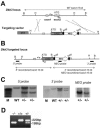Generation and characterization of dickkopf3 mutant mice
- PMID: 16508007
- PMCID: PMC1430294
- DOI: 10.1128/MCB.26.6.2317-2326.2006
Generation and characterization of dickkopf3 mutant mice
Abstract
dickkopf (dkk) genes encode a small family of secreted Wnt antagonists, except for dkk3, which is divergent and whose function is poorly understood. Here, we describe the generation and characterization of dkk3 mutant mice. dkk3-deficient mice are viable and fertile. Phenotypic analysis shows no major alterations in organ morphology, physiology, and most clinical chemistry parameters. Since Dkk3 was proposed to function as thyroid hormone binding protein, we have analyzed deiodinase activities, as well as thyroid hormone levels. Mutant mice are euthyroid, and the data do not support a relationship of dkk3 with thyroid hormone metabolism. Altered phenotypes in dkk3 mutant mice were observed in the frequency of NK cells, immunoglobulin M, hemoglobin, and hematocrit levels, as well as lung ventilation. Furthermore, dkk3-deficient mice display hyperactivity.
Figures



Similar articles
-
Advanced molecular profiling in vivo detects novel function of dickkopf-3 in the regulation of bone formation.J Bone Miner Res. 2006 Dec;21(12):1935-45. doi: 10.1359/jbmr.060819. J Bone Miner Res. 2006. PMID: 17002559
-
Expression analysis of Dickkopf-related protein 3 (Dkk3) suggests its pleiotropic roles for a secretory glycoprotein in adult mouse.J Mol Histol. 2017 Feb;48(1):29-39. doi: 10.1007/s10735-016-9703-2. Epub 2016 Nov 19. J Mol Histol. 2017. PMID: 27866302
-
Dickkopf homolog 3 (DKK3): A candidate for detection and treatment of cancers?J Cell Physiol. 2018 Jun;233(6):4595-4605. doi: 10.1002/jcp.26313. Epub 2018 Jan 15. J Cell Physiol. 2018. PMID: 29206297 Review.
-
Wnt signalling in human breast cancer: expression of the putative Wnt inhibitor Dickkopf-3 (DKK3) is frequently suppressed by promoter hypermethylation in mammary tumours.Breast Cancer Res. 2008;10(5):R82. doi: 10.1186/bcr2151. Epub 2008 Sep 30. Breast Cancer Res. 2008. PMID: 18826564 Free PMC article.
-
Function and biological roles of the Dickkopf family of Wnt modulators.Oncogene. 2006 Dec 4;25(57):7469-81. doi: 10.1038/sj.onc.1210054. Oncogene. 2006. PMID: 17143291 Review.
Cited by
-
The role of Dickkopf-3 overexpression in esophageal adenocarcinoma.J Thorac Cardiovasc Surg. 2015 Aug;150(2):377-385.e2. doi: 10.1016/j.jtcvs.2015.05.006. Epub 2015 May 8. J Thorac Cardiovasc Surg. 2015. PMID: 26093488 Free PMC article.
-
Microphthalmia, parkinsonism, and enhanced nociception in Pitx3 ( 416insG ) mice.Mamm Genome. 2010 Feb;21(1-2):13-27. doi: 10.1007/s00335-009-9235-0. Epub 2009 Dec 22. Mamm Genome. 2010. PMID: 20033184
-
Phosphatase WIP1 regulates adult neurogenesis and WNT signaling during aging.J Clin Invest. 2014 Jul;124(7):3263-73. doi: 10.1172/JCI73015. Epub 2014 Jun 9. J Clin Invest. 2014. PMID: 24911145 Free PMC article.
-
Dickkopf 3 Promotes the Differentiation of a Rostrolateral Midbrain Dopaminergic Neuronal Subset In Vivo and from Pluripotent Stem Cells In Vitro in the Mouse.J Neurosci. 2015 Sep 30;35(39):13385-401. doi: 10.1523/JNEUROSCI.1722-15.2015. J Neurosci. 2015. PMID: 26424886 Free PMC article.
-
Synaptic Wnt signaling-a contributor to major psychiatric disorders?J Neurodev Disord. 2011 Jun;3(2):162-74. doi: 10.1007/s11689-011-9083-6. Epub 2011 Apr 28. J Neurodev Disord. 2011. PMID: 21533542 Free PMC article.
References
-
- Bafico, A., G. Liu, A. Yaniv, A. Gazit, and S. A. Aaronson. 2001. Novel mechanism of Wnt signalling inhibition mediated by Dickkopf-1 interaction with LRP6/Arrow. Nat. Cell Biol. 3:683-686. - PubMed
-
- Bernal, J. 2002. Action of thyroid hormone in brain. J. Endocrinol. Investig. 25:268-288. - PubMed
-
- Bernal, J., and A. Guadaño-Ferraz. 2002. Analysis of thyroid hormone-dependent genes in the brain by in situ hybridization. Methods Mol. Biol. 202:71-90. - PubMed
-
- Bianco, A. C., D. Salvatore, B. Gereben, M. J. Berry, and P. R. Larsen. 2002. Biochemistry, cellular and molecular biology, and physiological roles of the iodothyronine selenodeiodinases. Endocr. Rev. 23:38-89. - PubMed
-
- Chapman, S. C., R. Brown, L. Lees, G. C. Schoenwolf, and A. Lumsden. 2004. Expression analysis of chick Wnt and frizzled genes and selected inhibitors in early chick patterning. Dev. Dyn. 229:668-676. - PubMed
Publication types
MeSH terms
Substances
LinkOut - more resources
Full Text Sources
Other Literature Sources
Medical
Molecular Biology Databases
